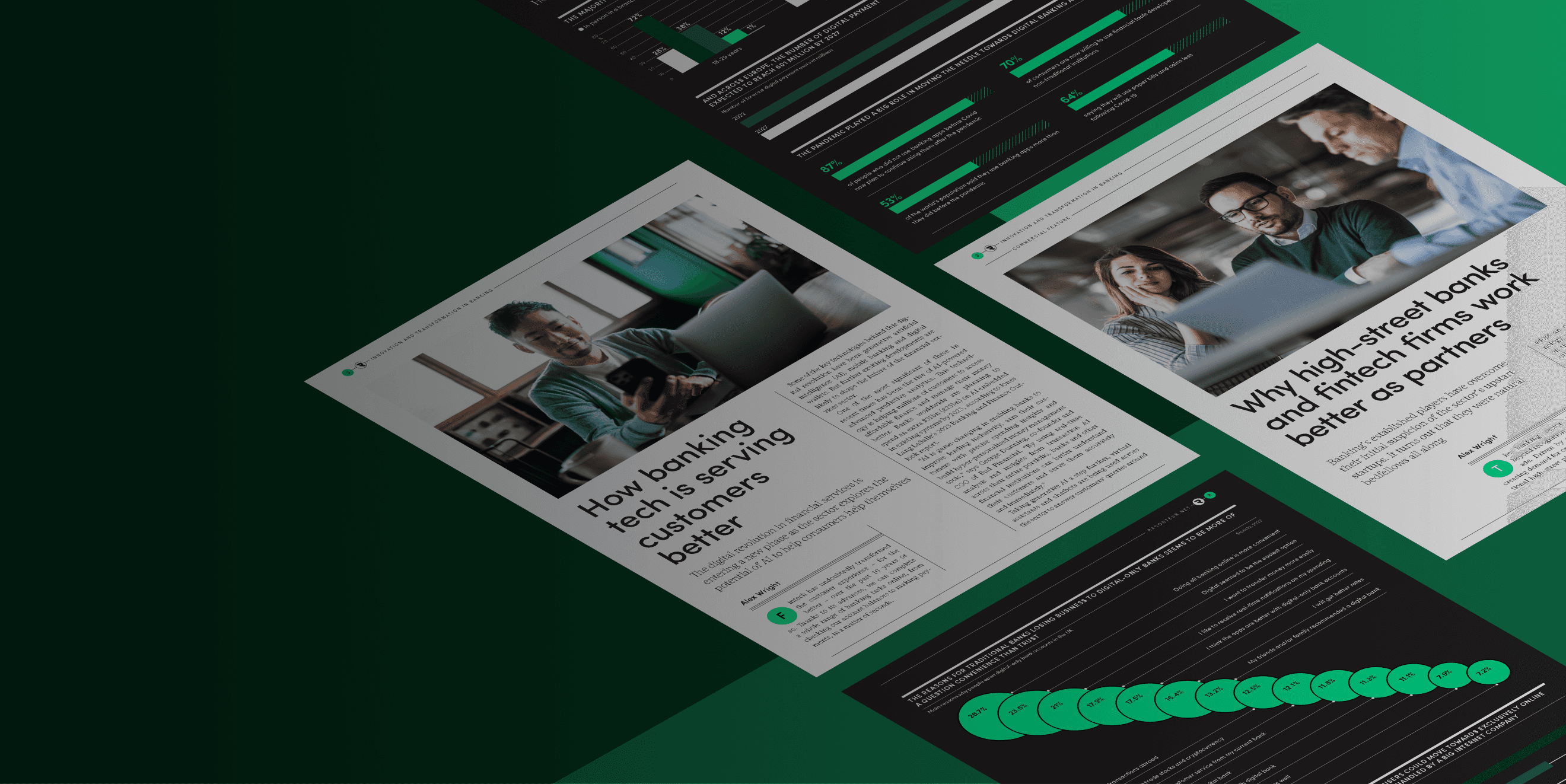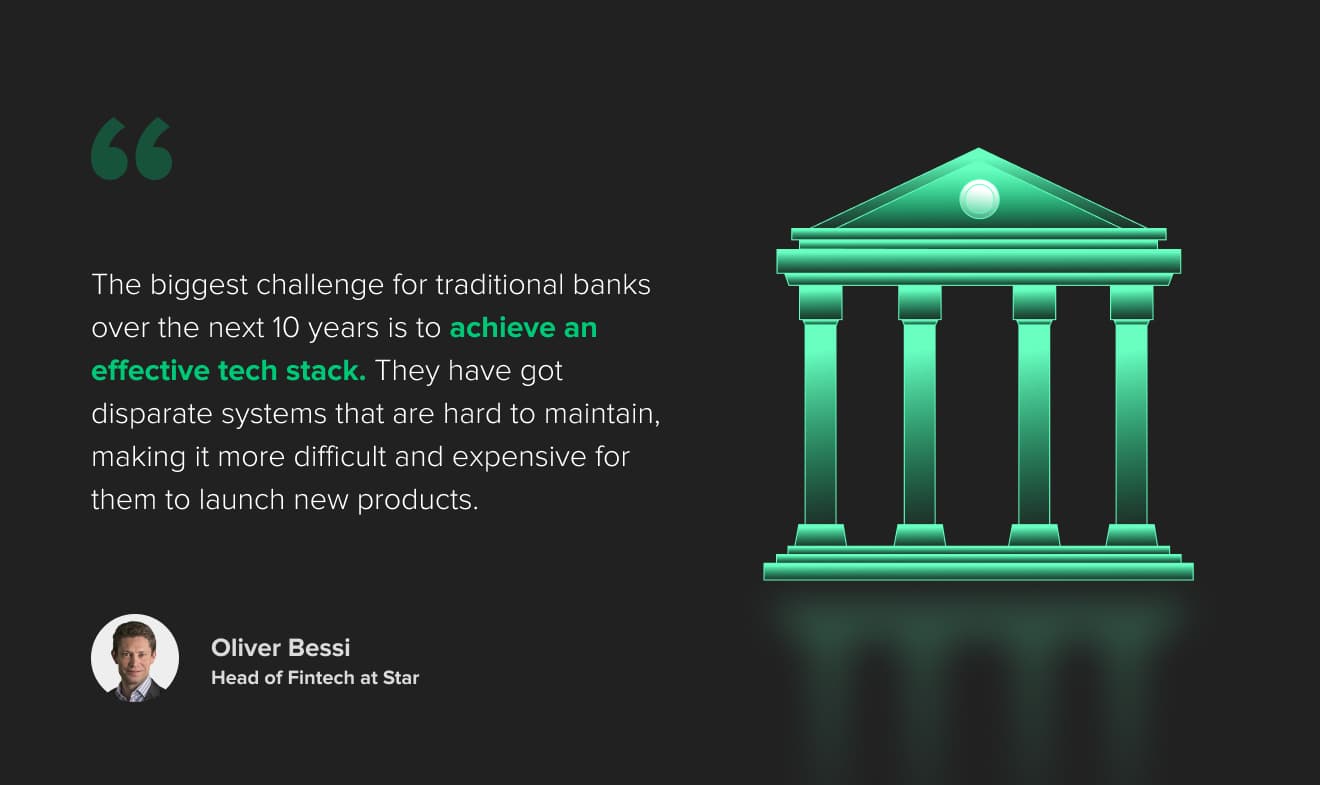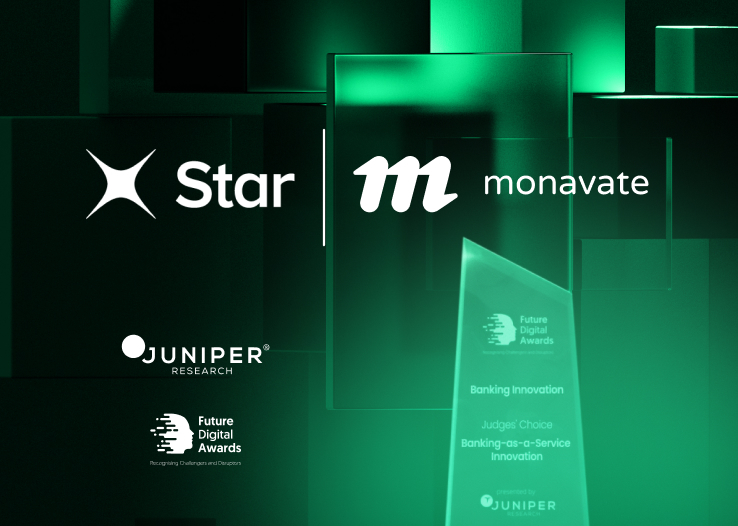Traditional banks and fintechs have long been seen as rivals, but could they actually reinforce each other? Each possesses strengths that the other lacks, and we believe that partnerships might just hold the answer.
As we continue closely investigating the changes in the evolving banking landscape, we sat down with Olivier Bessi, Head of Fintech, and Henning Holter, Business Development Director, to discuss the key factors bringing challenger banks and incumbents closer together. We delve into the potential of embedded payments, the challenges associated with legacy tech stacks, and the exciting opportunities for banks to leverage trust, expand revenue streams through marketplaces, and offer specialized financial services in this interview.
What do you believe has truly facilitated the closing of the gap between fintech, challenger banks, and incumbents in recent years?
Henning: I think loyalty has been tested much more than the banks anticipated. Younger people embrace new technology and convenience. It's really driven by who has the best and most convenient products, as opposed to who has the biggest, longest history.
Traditional banks were too slow to offer great online digital solutions, and new entrants happily exploited this.
Interestingly, I've spoken to a number of bank executives who have said that they weren't concerned about the challenger banks. The main reason was that they targeted current accounts, and there was often an attitude of “well, we don’t make any money on those anyway, so they can have them.”
Of course, what they didn’t realize was that this was a spearhead into people’s wallets and allowed challenger banks to build and grow new relationships across an increasingly growing service array.
Olivier: I couldn't agree more with Henning. What's interesting is to see many of the more traditional banks now launching their own digital ventures. For example, NatWest with Mettle, Goldman Sachs’ Marcus, and BBVA’s Azlo.
From this perspective, the gap is closing from the opposite direction, with incumbents establishing their own internal competitors to stay relevant in the digital space. At the same time, neobanks have acquired banking licenses and have become much more mature compared to a few years ago. All of this adds another twist to the narrative.

Be future-ready with in-depth banking industry analysis.
In the past, traditional banks might have been guilty of directly trying to compete with fintech integrations. Now we’re seeing something more nuanced. What’s going on?
Henning: I think some banks are actually quite capable of competing directly with fintech companies and carving out their own position in the market, but many are missing the agility and culture to keep up.
Instead, we see significant benefits for both sides in banks combining and cooperating with fintechs.
The reality is that executives who run big banks often have the wrong experience base. We’ve seen parallels in our work in the automotive industry.
Traditional automakers are being caught off guard because the industry is shifting towards becoming more software-oriented. Similarly, banks are experiencing the same challenge, requiring a different skill set to meet the evolving user experience expectations.
If you lack that mindset, you will miss out. Banks can learn a lot from partnering with fintech companies. It’s more than just hiring people to write the same code. There is a cultural difference that they can absorb and combine with their relative strengths to offer something compelling to customers.
Olivier: I find the B2B space to be of interest rather than solely focusing on pure B2C interactions. There aren't necessarily a lot of new integrations when it comes to consumer-facing fintech, simply because traditional banks have reservations about introducing outsiders and potential competitors to their services, even if there could be benefits from a user experience perspective.
However, I think there is much more potential in the B2B space and working with service providers. For example, in recent years, banks partnering with fintech companies like Wise has created new opportunities for non-core areas such as foreign exchange operations. Moves like these, especially for smaller banks, are a win-win helping to improve efficiency while still maintaining the client relationship.
Additionally, I believe there is significant value that traditional banks can derive from purchasing or utilizing services from core banking providers and other fintech companies, as opposed to relying on more traditional and potentially outdated software providers. These alternatives offer more streamlined and less cumbersome integrations.
What is the reasoning behind traditional banks feeling burdened by their legacy tech stack and their focus on it as central for competitiveness?
Olivier: The tech stack is, in my opinion, the main challenge that traditional banks will face in the next 10 years. This has been evident in the past few years as well. The banks are struggling with disparate systems that are difficult to maintain, resulting in increased complexity and expenses when launching new products.
To address this, partnering with best-in-class vendors in various areas could be a solution. It doesn't necessarily mean buying all the required components from a single vendor. Instead, banks can choose the best-in-class options for core banking, credit decision-making, card issuing processing, and other specific functionalities.
Henning: I agree. Banks have this view that all of their tech stack must be proprietary thinking they have to own it completely to compete. I think this is a huge mistake because very little of it actually has to be.
You know, the secret sauce is in the top 10%. Everything else that all banks do is the same thing. So if you think you’re competing based on your tech stack, you’re missing the point. Instead, leverage the opportunity to outsource and actually obtain better components of new technology from companies and integrate them into your systems. You don’t have to build everything. It's much easier to pick best-in-class components and be much more efficient in terms of your product delivery now than it was before.

Looking to the next 5 to 10 years, what should banks be doing to further build momentum?
Henning: It's very interesting to observe that most traditional banks are happy to stay local and build a strong local presence, while almost every startup has global ambitions from the beginning. This includes challenger banks, and it reflects a cultural attitude. So, why did Revolut just open an office in Brazil? I mean, you won't see a UK bank doing that anytime soon, right? However, there is no fundamental reason why incumbents and fintechs can’t compete with each other across the worldwide playing field.
My point is that if you can leverage the core strengths of an incumbent and combine them with the innovation of a startup, you can create an attractive proposition that embodies the ambitions of the innovator as well as the strength of the incumbent.
Banks will also need to understand how to integrate themselves into transactions in embedded payments. This change presents both opportunities and threats for banks. Traditionally, people and companies have purchased financial services separately from the commercial transaction. However, as the two are combined, it's crucial for banks to be involved; otherwise, they risk being disintermediated in the process.
This shift applies to various financial services, including mortgages, working capital financing, lines of credit, and more. The trend is moving away from purchasing these services separately. Instead, they will increasingly become a part of any transaction made, both on the B2B and B2C sides.
Olivier: I’d also say the idea of leveraging trust to sell cross-services. The banks on the continent are already very good at doing this. For example, if you're banking with BNP, it's likely they've also sold you life insurance and investment products, etc.
More banks should seize this opportunity because now smaller banks, not necessarily the mega banks, can leverage fintech and technology to build marketplaces and, essentially, generate additional revenue from a wide variety of new sources.
How can banks effectively strike a balance between maintaining security and trust while also driving progress?
Henning: I think banks and fintechs both have something to offer — the user experience from fintechs and the understanding of compliance and regulation from the banks. Regulation usually favors the incumbent because they are better able to fund and manage compliance initiatives.
So, I think they can leverage that advantage to build the trust that customers and regulators need in order to perform without making the mistakes that new banks do.
At the same time, incumbents must combine this with more elegant fintech solutions for banks such as KYC and AML that many fintech companies are offering. They also need a better understanding of open banking and fine-tuning the right level of friction that’s necessary for building the compliance function.
Olivier: I would say there's also a lot happening in terms of transaction monitoring and fraud detection. It's a crucial topic for banks because it affects many of their customers, and costs banks a significant amount of money as they often reimburse customers who fall victim to fraud.
Therefore, being able to connect with third-party providers for fraud detection is a key element of security. The models used by these providers for detection will continue to increase in complexity and efficiency.
Wrapping up, what other digital banking trends should we be paying attention
to right now?
Henning: There’s been a lot of talk about Big Tech entering the finance sector. I believe that Big Tech firms are not eager to become heavily regulated, as it would present significant challenges for them. While they may not be large enough to require strict regulations, complying with them would add complexity and disrupt their operations.
Instead, Big Tech can collaborate with banks to handle the regulatory aspects of financing. Their strength lies in their user interface and the pivotal moment when customers require financing, where they are positioned as the first choice.
This brings us back to the concept of embedded payments, where Big Tech can directly offer financing at the point of need, eliminating the need for customers to seek financing elsewhere.
Therefore, whether it's payments, loans, lines of credit, or cross-border transactions, Big Tech firms are well-positioned to provide these services without necessarily needing to be regulated themselves, as they can rely on partnering with banks to fulfill regulatory requirements.
This is something that banks need to be mindful of, as it has the potential to quickly erode their traditional core business or become a key growth point through the right partnerships.
Olivier: Traditional banks continue to dominate the lending space, which is a significant source of revenue for them, while most neobanks don't really provide credit. While some have credit cards, they don't offer lending services for consumer loans or mortgages.
This means there is a risk for challengers to always be considered the secondary bank until they can offer such services. So, you may have your primary bank, the one where you have your mortgage, and then perhaps you use Revolut or a similar service for an easy-to-use debit card and loyalty points, etc.
However, the growing opportunity space lies in the rapid expansion of niche providers who offer specialized financial services, such as loyalty cards, single-purpose cards, and purchasing cards, thereby creating a diverse ecosystem of smaller companies catering to specific customer needs.
Star: helping banks fuel agility, collaboration, and transformation
Agility and seamless collaboration are key to navigating the ever-changing finance sector landscape and shaping the future of banking. We're here to empower you with the tools, partnerships, and expertise to help you thrive. Foster meaningful collaboration with fintechs, accelerate digital transformation journeys, and reduce MVP development from 12-18 months to 3-6 months. Get in touch with us to learn more.





